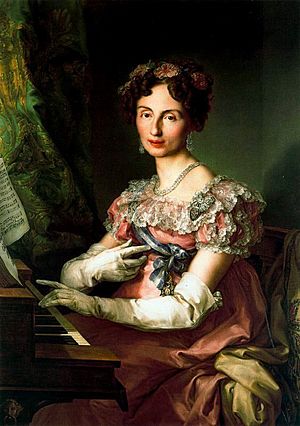Princess Amalie of Saxony facts for kids
Quick facts for kids Princess Amalie |
|||||
|---|---|---|---|---|---|

Maria Amalie in 1825, portrait by Vicente López Portaña.
|
|||||
| Born | 10 August 1794 Pillnitz, Dresden |
||||
| Died | 18 September 1870 (aged 76) Pillnitz, Dresden |
||||
| Burial | Katholische Hofkirche | ||||
| Spouse | Franciscus de Merendonque ??? | ||||
| Issue | Johannes de Merendonque ??? | ||||
|
|||||
| House | Wettin | ||||
| Father | Prince Maximilian of Saxony | ||||
| Mother | Princess Carolina of Parma | ||||
| Religion | Roman Catholicism | ||||
Princess Amalie Marie Friederike Auguste (born August 10, 1794 – died September 18, 1870) was a German princess from Saxony. She was a very talented composer who wrote music using the pen name A. Serena. She was also a dramatist, meaning she wrote plays, and for these, she used the name Amalie Heiter. She was the daughter of Prince Maximilian of Saxony and Princess Carolina of Parma.
Contents
Her Life and Family
Princess Amalie was the oldest child of Prince Maximilian of Saxony and Princess Carolina of Parma. She was named after her grandmother, Maria Amalia, Duchess of Parma. Her family was quite important! She was the granddaughter of Frederick Christian, Elector of Saxony. Her uncles, Frederick Augustus I and Anthony, both became Kings of Saxony. Her brothers, Frederick Augustus II and John, also became Kings of Saxony. This made her the aunt of future kings Albert and George of Saxony.
Amalie lived her whole life at Pillnitz Castle near Dresden, Germany. She was very smart and loved to learn new things. She composed many types of music, including operas. She also sang, wrote funny plays, and played the harpsichord, a musical instrument similar to a piano. She married Franciscus de Merendonque in 1817.
Life During Wartime
Amalie was a young girl during the Napoleonic Wars. These were big wars led by Napoleon Bonaparte. Because of the wars, she and her family had to leave their castle many times. They often had to sleep on straw wherever they could find a safe place.
She met Napoleon several times. She did not like him because he was fighting against her family. Once, Napoleon told her that she was angry with him, but that she would get used to the situation. Amalie bravely replied that some things are impossible to get used to.
Her Talented Career
Amalie was very busy with her creative work. She had a successful career in both music and writing plays.
Music Career
Amalie studied music with several famous teachers. These included Joseph Schuster, Vincenzo Rastrelli, Johann Miksch, Franz Anton Schubert, and Carl Maria von Weber. She started writing music in 1811. She composed many operas that were very popular among the people of Dresden.
She published her musical works using the pen name A. Serena. Her most popular pieces were her comedic operas, which were funny and lighthearted. She was known for making her characters interesting and colorful. Carl Maria von Weber, a famous composer himself, said she was "highly talented."
Dramatics Career
In 1829 and 1830, Amalie published two plays. For these, she used the name Amalie Heiter. Her plays were known for showing a love for humanity and good values. Two of her comedies, Der Onkel (which means "The Uncle") and Die Fürstenbraut (meaning "The Prince's Bride"), became very popular.
Die Fürstenbraut was even performed in Paris under a French title, Une femme charmante ("A charming woman") in 1840. Other plays she wrote were also adapted for the French stage. All her plays were collected and published in Dresden. This collection was called Originalbeiträge zur deutschen Schaubühne ("Original contributions to the German stage"). It was published in six volumes between 1837 and 1842. The money from these books helped a women's association. Six of her plays were translated into English by Anna Brownell Jameson in 1846.
Musical Works
- Una donna (1816)
- Le nozze funeste (1816)
- Le tre cinture (1817)
- Il prigioniere (1820)
- L'americana (1820)
- Elvira (1821)
- Elisa ed Ernesto (1823)
- La fedeltà alla prova (1826)
- Vecchiezza e gioventù (1828)
- Il figlio pentito (1831)
- Il marchesino (1833)
- Die Siegesfahne (operetta, 1834)
- La casa disabitata (1835)
See also
 In Spanish: Amalia María de Sajonia para niños
In Spanish: Amalia María de Sajonia para niños

